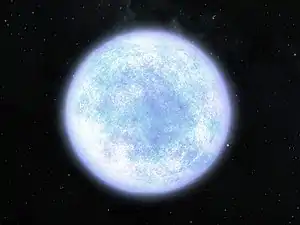Blue dwarf (red-dwarf stage)
A blue dwarf is a predicted class of star that develops from a red dwarf after it has exhausted much of its hydrogen fuel supply. Because red dwarfs fuse their hydrogen slowly and are fully convective (allowing their entire hydrogen supply to be fused, instead of merely that in the core), the Universe is currently not old enough for any blue dwarfs to have formed yet, but their future existence is predicted based on theoretical models.[1]

Stars increase in luminosity as they age, and a more luminous star needs to radiate energy more quickly to maintain equilibrium. Stars larger than red dwarfs do this by increasing their size and becoming red giants with larger surface areas. Rather than expanding, however, red dwarfs with less than 0.25 solar masses are predicted to increase their radiative rate by increasing their surface temperatures and becoming "bluer". This is because the surface layers of red dwarfs do not become significantly more opaque with increasing temperature.[1]
Blue dwarfs eventually evolve into white dwarfs once their hydrogen fuel is completely exhausted,[1] which in turn will eventually cool to become black dwarfs.
See also
- Wolf–Rayet star – Stars with unusual spectra showing prominent broad emission lines of highly ionised helium and nitrogen or carbon
References
- Adams, F. C.; P. Bodenheimer; G. Laughlin (2005). "M dwarfs: planet formation and long term evolution". Astronomische Nachrichten. 326 (10): 913–919. Bibcode:2005AN....326..913A. doi:10.1002/asna.200510440.